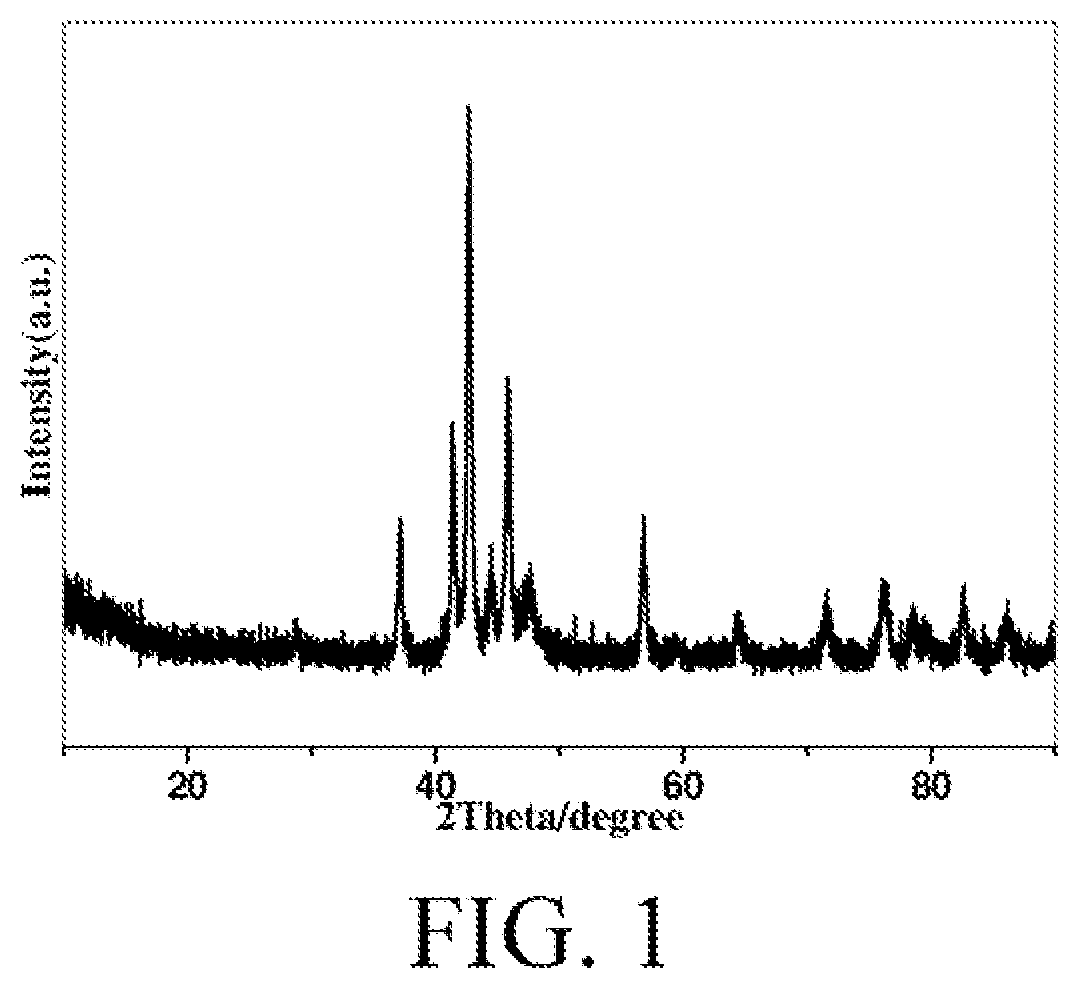Cobalt carbide-based catalyst for direct preparation of olefin from synthesis gas, preparation method therefor and application thereof
a catalyst and olefin technology, applied in the field of catalyst technology, can solve the problems of reducing the catalyst life, destroying the apparatus, and increasing the temperature not necessarily favorable to the f-t synthesis reaction, and achieves the effects of high catalytic activity, low selectivity to methane, and high selectivity to olefins
- Summary
- Abstract
- Description
- Claims
- Application Information
AI Technical Summary
Benefits of technology
Problems solved by technology
Method used
Image
Examples
example 1
[0058]Cobalt nitrate was fully dissolved in water by stirring at a molar ratio of cobalt nitrate:water=1:25, to obtain a first solution. Sodium carbonate was fully dissolved in water by stirring at a molar ratio of sodium carbonate:water=1:25, to obtain a second solution. A certain amount of deionized water is prepared according to a weight ratio of cobalt:water=1:10. Both the first solution and the second solution were added dropwise to the deionized water at a precipitation temperature of 60° C. and pH controlled to 8. After addition, it was crystallized at a temperature of 60° C. for 2 hours, and centrifuged. The obtained solid product was dried at 80° C. for 12 hours, and the dried solid was calcined at 330° C. for 4 hours. The solid was reduced for 4 hours at 250° C. under a pure H2 atmosphere of 0.1 MPa at a space velocity of 8000 h−1, and then carbonized for 6 hours at 250° C. under a CO atmosphere of 0.1 MPa at a space velocity of 8000 h−1. FIG. 1 shows an X-ray diffraction ...
example 2
[0059]Cobalt nitrate and manganese nitrate were fully dissolved in water by stirring at a molar ratio of cobalt nitrate:manganese nitrate:water=1:5:25, to obtain a first solution. Sodium carbonate was fully dissolved in water by stirring at a molar ratio of sodium carbonate:water=1:25, to obtain a second solution. A certain amount of deionized water is prepared according to a weight ratio of cobaltwater=1:100. Both the first solution and the second solution were added dropwise to the deionized water at a precipitation temperature of 30° C. and pH controlled to 8. After addition, it was crystallized at a temperature of 30° C. for 4 hours, and centrifuged. The obtained solid product was dried at 80° C. for 10 hours, and the dried solid was calcined at 330° C. for 3 hours. The solid was reduced for 5 hours at 300° C. under a 10% H2 / Ar atmosphere of 1 MPa at a space velocity of 8000 h−1, and then carbonized for 8 hours at 250° C. under a CO atmosphere of 0.1 MPa at a space velocity of 8...
example 3
[0060]Cobalt acetate was fully dissolved in water by stirring at a molar ratio of cobalt acetate:water=1:25, to obtain a first solution. Sodium carbonate was fully dissolved in water by stirring at a molar ratio of sodium carbonate:water=1:1000, to obtain a second solution. A certain amount of deionized water is prepared according to a weight ratio of cobalt:water=1:20. Both the first solution and the second solution were added dropwise to the deionized water at a precipitation temperature of 60° C. and pH controlled to 8. After addition, it was crystallized at a temperature of 180° C. for 2 hours, and centrifuged. The obtained solid product was dried at 80° C. for 12 hours, and the dried solid was calcined at 330° C. for 4 hours. The solid was reduced for 4 hours at 250° C. under a pure H2 atmosphere of 10 MPa at a space velocity of 10000 h−1, and then carbonized for 6 hours at 250° C. under a CO atmosphere of 0.1 MPa at a space velocity of 8000 h−1. Reaction was carried out with s...
PUM
| Property | Measurement | Unit |
|---|---|---|
| temperature | aaaaa | aaaaa |
| temperature | aaaaa | aaaaa |
| temperature | aaaaa | aaaaa |
Abstract
Description
Claims
Application Information
 Login to View More
Login to View More - R&D
- Intellectual Property
- Life Sciences
- Materials
- Tech Scout
- Unparalleled Data Quality
- Higher Quality Content
- 60% Fewer Hallucinations
Browse by: Latest US Patents, China's latest patents, Technical Efficacy Thesaurus, Application Domain, Technology Topic, Popular Technical Reports.
© 2025 PatSnap. All rights reserved.Legal|Privacy policy|Modern Slavery Act Transparency Statement|Sitemap|About US| Contact US: help@patsnap.com

